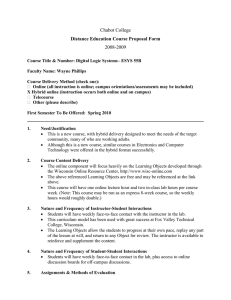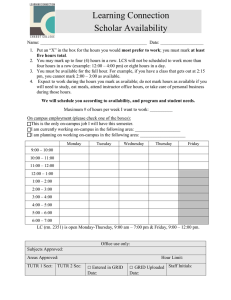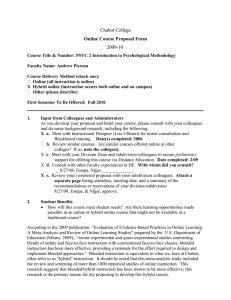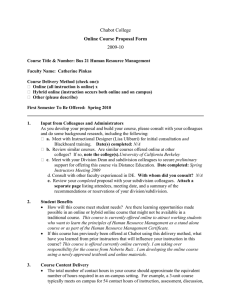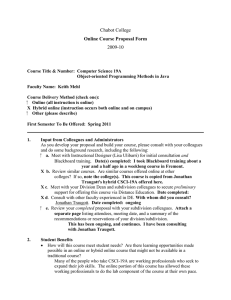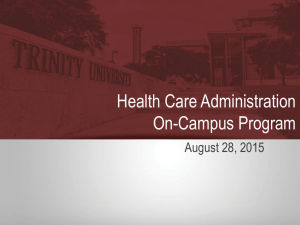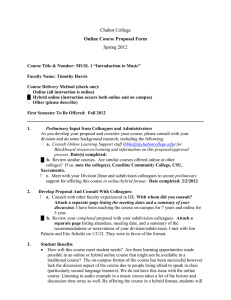Chabot College 2009-10 Online Course Proposal Form
advertisement
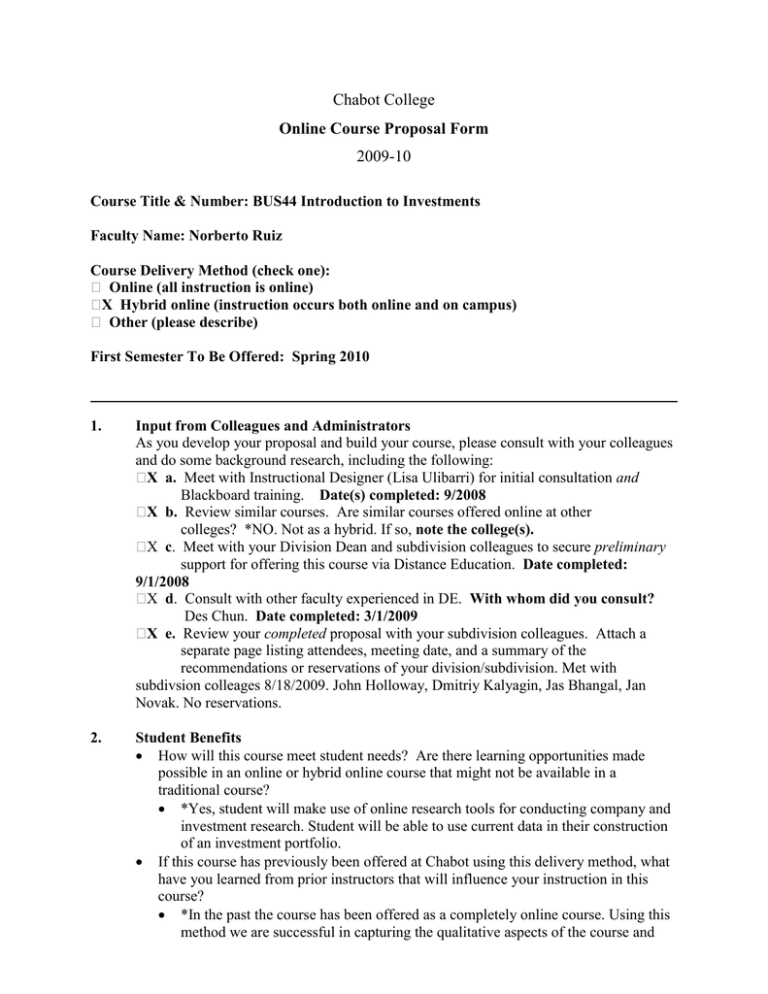
Chabot College Online Course Proposal Form 2009-10 Course Title & Number: BUS44 Introduction to Investments Faculty Name: Norberto Ruiz Course Delivery Method (check one): Online (all instruction is online) X Hybrid online (instruction occurs both online and on campus) Other (please describe) First Semester To Be Offered: Spring 2010 1. Input from Colleagues and Administrators As you develop your proposal and build your course, please consult with your colleagues and do some background research, including the following: X a. Meet with Instructional Designer (Lisa Ulibarri) for initial consultation and Blackboard training. Date(s) completed: 9/2008 X b. Review similar courses. Are similar courses offered online at other colleges? *NO. Not as a hybrid. If so, note the college(s). X c. Meet with your Division Dean and subdivision colleagues to secure preliminary support for offering this course via Distance Education. Date completed: 9/1/2008 X d. Consult with other faculty experienced in DE. With whom did you consult? Des Chun. Date completed: 3/1/2009 X e. Review your completed proposal with your subdivision colleagues. Attach a separate page listing attendees, meeting date, and a summary of the recommendations or reservations of your division/subdivision. Met with subdivsion colleages 8/18/2009. John Holloway, Dmitriy Kalyagin, Jas Bhangal, Jan Novak. No reservations. 2. Student Benefits How will this course meet student needs? Are there learning opportunities made possible in an online or hybrid online course that might not be available in a traditional course? *Yes, student will make use of online research tools for conducting company and investment research. Student will be able to use current data in their construction of an investment portfolio. If this course has previously been offered at Chabot using this delivery method, what have you learned from prior instructors that will influence your instruction in this course? *In the past the course has been offered as a completely online course. Using this method we are successful in capturing the qualitative aspects of the course and less successful in demonstrating the quantitative aspects of the course. With the on-campus portion of the course time, we will be able to focus on and more fully developing the quantitative aspects of the course. 3. Course Content Delivery The total number of contact hours in your course should approximate the equivalent number of hours required in an on-campus setting. For example, a 3-unit course typically meets on campus for 54 contact hours of instruction, assessment, discussion, and group activities. In the Carnegie unit system, students are also expected to invest two hours “outside of class” for every hour in class on reading, studying, preparing assignments, and other homework; these additional hours are not considered to be “contact hours”. Account for the contact hours in your proposal. * Contact hours: 35 contact hours on-campus, lecture and discussion; 35 contact hours online as follows – 18 hours online specific investment research and analysis using publicly available online financial resources and instructor authored materials; 7 hours of discussion boards topics; 8 hours online quizzes. As per the Carnegie unit, there will be a minimum of 140 of hours required in the reading, studying, preparing assignments and other related homework that are not part of the above contact hours. What percentage of the course will be on-campus, if any? *50 percent of the course will be on-campus. What percentage of the course will consist of online lecture, video, podcasts, email, supplemental websites, CD-ROM, etc.? *Supplemental website course work will consist of 18 hours (25 percent) *35 hours of the course will occur online, 35 hours of the course be on-campus for a total of 70 hours in this 4 semester unit course. Will any portion of your course be synchronous, requiring students to be online at the same time? If so, describe those activities, and how you will provide flexibility for students who may be unable to participate at any given time. *As the course will have weekly on-campus meetings, these meetings be their nature are synchronous, so no online synchronous meetings are planned. 4. Nature and Frequency of Instructor-Student Interactions How and how frequently will you interact with your students? This should include interactions with the entire class, providing feedback on assignments, and interventions when students are at-risk of dropping or failing due to poor performance or participation. *The class will meet weekly on-campus; in addition their will be weekly discussion board topics to which students must post. For each type of interaction, describe why you believe it will be effective for this particular course. *The discussion allows students to interact outside of the classroom and continue development of the ideas presented on-campus. 5. Nature and Frequency of Student-Student Interactions Describe opportunities in your course for student to student interaction. This may include discussions, group projects, peer review of assignments, and other approaches. Consider how students interact in this course when taught on campus; how can you build this type of learning community online? o *Students will respond to the discussion board postings of other students, students will each be presenting their investment project the class and all class students will need to provide analysis and feedback to each student’s project outcomes and findings. I expect the class to be highly interactive; everyone has an opinion on differing investment approaches. 6. Assessment of Student Learning How will you assess learning in this course? Given the nature of online courses, how does your assessment plan ensure a level of academic integrity with which you’re comfortable? *There will be one quiz per chapter, a comprehensive final examination, graded discussion board assignments, internet research assignments and a semester project may be individual or group. I provide feedback on all assessed worked, usually within days of the assignment. Quizzes provided online are graded immediately within instantaneous feedback. Describe how your assessment plan is consistent with your stated goals in the student benefits and student-student interactions sections of your proposal. How will you provide feedback to students? *Students receive feedback during class meetings and via e-mail. Quizzes and written assignments are corrected and recorded within the week. There are discussion board topics posted to which students respond and to which students respond to each other postings. 7. Technology Describe any special software or multimedia tools you plan to utilize in your course (Articulate, Camtasia, Captivate, Flash, podcasts, videocasts, etc.). This is helpful to determine technology support needs. *In the fully online version of this course I have used podcasts, but in this hybrid version of the course I plan on keeping the technology requirements to a minimum use of special software. I may implement some Camtasia presentations. 8. Accommodations for Students with Disabilities Is any required video close-captioned? *Will not be using video in this course. Is any required audio accompanied by a transcript? *Will not being using audio. If you plan to use any multimedia (video, podcasts, specialized software), is that accessible to your students in terms of both software availability at home and on campus and accessible for students with disabilities? *Student will need to use Adobe’s standard PDF file reader. Have you provided alt-tags for your key images used in your course? Yes. Please meet with the DSRC if you need help in ensuring accessibility for your students. Instructor will work with the DRSC to reasonable accommodate any special students’ need. (As I always have.) 9. Submit your proposal (electronic version via email and hard copy via campus mail) to the chair of the Committee on Online Learning. Faculty signature: _______________________________ Date: _______________ Division Dean signature: __________________________ Date: ________________
